Normally I look for sunny weather, but if we had come to a rain forest (the first real rain forest we’ve camped in) and it had not been raining I would have been disappointed. I envisioned something primeval and dark, with moss hanging from everything, and a constant state of rain that fluctuated between drips from the giant tree leaves and steady showers.
So I have not been disappointed. The Hoh Valley is the perfect place to make rain. Moist Pacific air comes to land, carried by the “Westerlies” (an onshore breeze), and funnels into the Hoh Valley as it is pushed up by the rising landscape of the Olympic Mountain Range. Inevitably it cools and precipitates down to the giant trees that thrive in this mild wet spot, to the tune of 140 inches of rain each year. By comparison, our home base of southern Arizona gets only about a dozen inches of rain each year.
The Hoh Rain Forest will get 22-30 inches of rain this month, since we are approaching the really wet winter season. We drove through light to moderate showers for forty miles along Rt 101 and up the 20-mile Hoh Valley road, and as we approached the park interior the trees kept getting bigger and the forest grew more dramatic. The big leaves that cover the ground everywhere are from the appropriately-named “Big Leaf Maple” and they are often a foot wide. The moss finds purchase nearly everywhere, including trees, bridges, rocks, unused handrails “¦ any spot that is relatively undisturbed by the friction of feet, hooves, or water.
This time of year there are predictably few visitors, but I think this may be the best time to really experience the Hoh Rain Forest. It gets cold up above 3,500 feet, and snow is falling up there, but not here. The temperature has remained nearly constant at 47-52 degrees, a good temperature for hiking, and the air is still. Yesterday on the drive over we stopped to hike to Marymere Falls (an easy 1.5 mile roundtrip near Lake Crescent) and it was so comfortable that we spent most of the time in the forest studying the diversity of mushrooms and banana slugs that live in there, recycling the downed trees. Only near the falls, where a breeze was being generated, did it feel the slightest bit chilly.
Here in “the Hoh” they are predicting an unusual event for Monday, partly sunny skies and up to 61 degrees. I might even feel a little disappointed if it comes true. While we are here it may as well rain as much as possible, so we’ll never lose the sensation of being in the rain forest while we are camped.
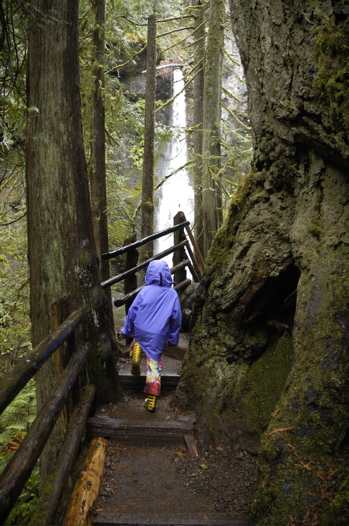 On the way here we passed one of Olympic’s record-setting giant trees. The moist climate allows Sitka Spruce to grow here, and there’s one near the road that is over 500 years old and 12 feet wide. Towering 270 feet straight up, it is impossible to photograph accurately. I have tried many times over the years to capture in a photo the sensation of standing beside a mammoth tree like this and each time I have failed. You really have to experience it yourself. It is an extraordinary thing, and even more thrilling when you realize that this country used to be covered in massive old-growth trees like this. Imagine walking through a forest filled with huge trees ranging from four to fifteen feet at their bases, and with the canopy 200-300 feet above your head. It’s kind of thing we only see in movies, or in those rare remaining spots where true old-growth forests still exist.
On the way here we passed one of Olympic’s record-setting giant trees. The moist climate allows Sitka Spruce to grow here, and there’s one near the road that is over 500 years old and 12 feet wide. Towering 270 feet straight up, it is impossible to photograph accurately. I have tried many times over the years to capture in a photo the sensation of standing beside a mammoth tree like this and each time I have failed. You really have to experience it yourself. It is an extraordinary thing, and even more thrilling when you realize that this country used to be covered in massive old-growth trees like this. Imagine walking through a forest filled with huge trees ranging from four to fifteen feet at their bases, and with the canopy 200-300 feet above your head. It’s kind of thing we only see in movies, or in those rare remaining spots where true old-growth forests still exist.
In the Visitor Center we bought Emma a little laminated booklet that helps identify animal tracks and scat. Right away we had opportunity to use it, because there are numerous piles of fresh scat only a few feet from our campsite, probably Elk.
To one side of the Airstream is the rushing gray river, deep and fierce and wild-looking. It is bounded by fields of rounded rocks, tall pines and cedars, and dramatic valley landscape. To the other side we can see only trees disappearing into the fog, and above us there is an ever-present gray sky. Although the campground is quite civilized, and the water is never turned off here, there are only two other campers.
As you might expect, we are not getting much power from the solar panels. Not only is it constantly cloudy here, but tall trees shade every campsite, every parking spot, and even the road-side pull-outs. We voluntarily spent last night in the non-electric part of Salt Creek Recreation Area, but I mistakenly left the middle Fantastic Vent wide open all night, and as a result the furnace ran far too much. This used up 43% of our battery capacity in one night! (Have I mentioned lately how annoyed I am at the inefficiency of RV furnaces? I can’t wait to get that catalytic heater installed.) If we had the standard two batteries installed they would have been dead in the morning, but fortunately we’ve got four.
So we started off in Hoh with only about half our power bank remaining, and picked up virtually no solar power during the day on Sunday. Fortunately, the mild nights here mean that if I remember to close the vent tonight we will use much less power for the furnace. We should be fine for one more night before we head to the coast.
In any case, I’m not worrying about it. We watched a movie on the laptop and Eleanor and Emma baked an apple crisp using apples they’d picked from Janie’s tree in Montana. The trailer smells homey from the baked crisp, while the constant patter of rain on the aluminum is a reminder of the unusual place we’re in.
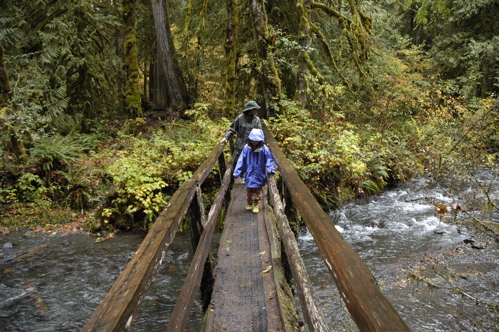
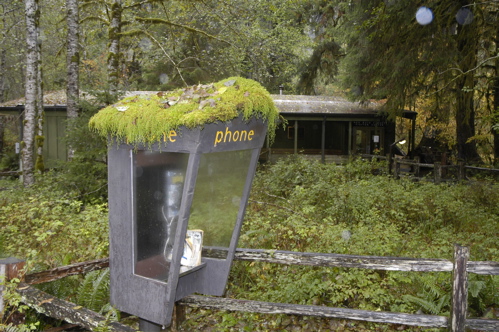
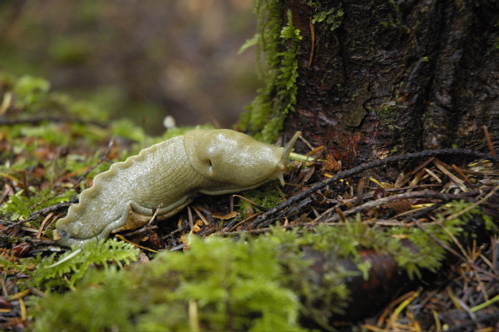
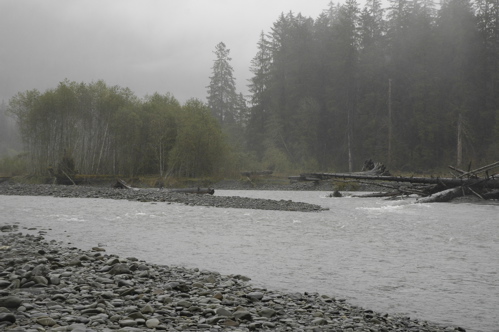


October 22nd, 2007 at 8:16 pm
oh, it’s home.
October 23rd, 2007 at 7:08 am
old trailers have a gravity furnace, no electric. met a guy with a 65 AS with one. don’t know, but it might be tall?
ever think of using an 8 settings per day timer. sure you could figure out how to use it with 12 v.
using the settings you could allow the furnace to operate only for short periods during the night. before rising the furnace could be allowed to operate making the AS comfortable for the morning.
a separate battery installed under the tow vehicle completely out of the way to be charged when you are out & about could be set up to only feed only one 12v applicance. detail: the furnace could be ‘plugged’ into either the trailer wiring as it is now OR ‘plugged’ into the separate battery. worse case: the separate battery loses power during the night and gets charged up when using the tow vehicle.
pff